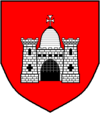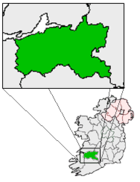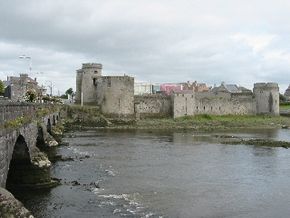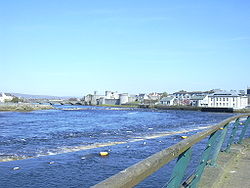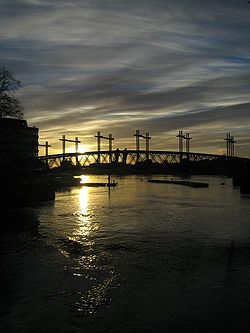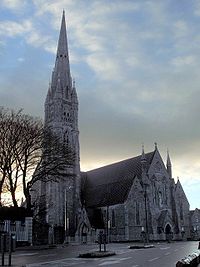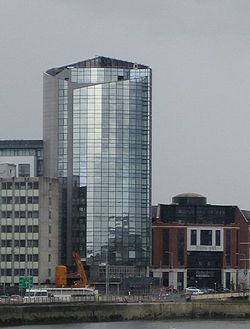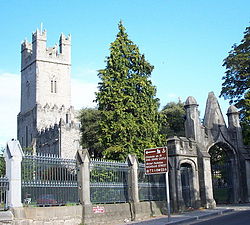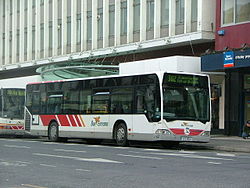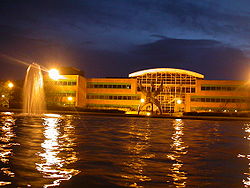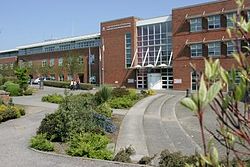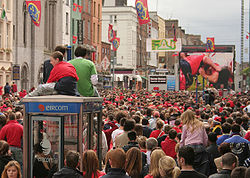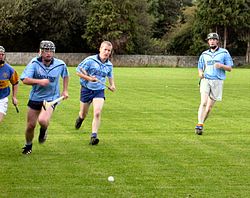
Limerick
Background to the schools Wikipedia
This content from Wikipedia has been selected by SOS Children for suitability in schools around the world. SOS mothers each look after a a family of sponsored children.
| Limerick Luimneach Treaty City Riverside City |
|||
|---|---|---|---|
|
|||
| Motto: Urbs Antiqua Fuit Studiisque Asperrima Belli (Latin) "An ancient city well-versed in the arts of war" |
|||
|
|
|||
| Coordinates: 52°39′46″N 8°37′43″W | |||
| Country | Ireland | ||
| Province | Munster | ||
| County | Limerick | ||
| Area | |||
| • City | 37.3 km2 (14.4 sq mi) | ||
| Population | |||
| • City | 52,539 | ||
| • Metro | 90,757 | ||
| Time zone | WET ( UTC0) | ||
| • Summer ( DST) | IST ( UTC+1) | ||
| Area code(s) | (+353) 61 | ||
| Car plates | L | ||
| Website | www.limerickcity.ie | ||
Limerick (pronounced /ˈlɪmrɪk/; Irish: Luimneach [ˈl̪imʲɨnʲəx]) is the third largest city in the Republic of Ireland, and the principal city in County Limerick. Limerick is the second-largest city in the province of Munster, an area which constitutes the midwest and southwest of Ireland.
Limerick is situated on several curves and islands of the River Shannon, which spreads into an estuary shortly after Limerick. Road infrastructure features three main crossing points near the city centre (an additional river tunnel to the west of the three bridges is expected to open in 2010), and in 2006 the Limerick urban area had a population of 91,000. Limerick is one of the constituent cities of the Cork-Limerick-Galway corridor, which has a population of 1 million.
History
Luimneach originally referred to the general area along the banks of the Shannon Estuary known as Loch Luimnigh. The earliest settlement in the city, Inis Sibhtonn, was the original name for King's Island during the pre-Viking and Viking eras. This island was also called Inis an Ghaill Duibh, The Dark(haired) Foreigner's Island. The name is recorded in Viking sources as Hlymrekr.
The city dates from at least the Viking settlement in 812. The Normans redesigned the city in the 12th century and added much of the most notable architecture, such as King John's Castle and St Mary's Cathedral. During the civil wars of the 17th century the city played a pivotal role, besieged by Oliver Cromwell in 1651 and twice by the Williamites in the 1690s. Limerick grew rich through trade in the late 18th century, but the Act of Union in 1800 and the famine caused a crippling economic decline broken only by the so-called Celtic Tiger in the 1990s.
The Waterford and Limerick Railway linked the city to the Dublin- Cork main line in 1848 and to Waterford in 1853. The opening of a number of secondary railways in the 1850s and 1860s developed Limerick as a regional centre of communications.
Geography
Limerick is at the centre of the Midwest region, which contributed €8.224 billion in 2002 to Irish GDP. It is 195 km west of Dublin and is 105 km from both Cork to the south and Galway to the north.
Climate
Limerick has a mild climate, with the average daily maximum in July of 20°C (68°F) and the average daily minimum in January of 4°C (39°F). The highest temperature recorded was 31.6°C (88.9°F) in 1995, and the lowest -11.2°C (11.4°F) in 1998.
| Limerick, Ireland ( XXXX-XXXX) | ||||||||||||||||||||||||||||||||||||||||||||||||||||||||||||
|---|---|---|---|---|---|---|---|---|---|---|---|---|---|---|---|---|---|---|---|---|---|---|---|---|---|---|---|---|---|---|---|---|---|---|---|---|---|---|---|---|---|---|---|---|---|---|---|---|---|---|---|---|---|---|---|---|---|---|---|---|
| Climate chart ( explanation) | ||||||||||||||||||||||||||||||||||||||||||||||||||||||||||||
|
||||||||||||||||||||||||||||||||||||||||||||||||||||||||||||
|
||||||||||||||||||||||||||||||||||||||||||||||||||||||||||||
| Historical population | ||
|---|---|---|
| Year | Pop. | ±% |
| 1659 | 3,105 | — |
| 1821 | 59,045 | +1801.6% |
| 1831 | 66,554 | +12.7% |
| 1841 | 48,391 | −27.3% |
| 1851 | 48,785 | +0.8% |
| 1861 | 43,924 | −10.0% |
| 1871 | 39,353 | −10.4% |
| 1881 | 38,562 | −2.0% |
| 1891 | 37,155 | −3.6% |
| 1901 | 38,151 | +2.7% |
| 1911 | 38,518 | +1.0% |
| 1926 | 39,448 | +2.4% |
| 1936 | 41,061 | +4.1% |
| 1946 | 42,970 | +4.6% |
| 1951 | 50,820 | +18.3% |
| 1956 | 51,666 | +1.7% |
| 1961 | 51,732 | +0.1% |
| 1966 | 58,082 | +12.3% |
| 1971 | 57,161 | −1.6% |
| 1979 | 60,665 | +6.1% |
| 1981 | 60,736 | +0.1% |
| 1986 | 56,279 | −7.3% |
| 1991 | 52,083 | −7.5% |
| 1996 | 52,039 | −0.1% |
| 2002 | 54,023 | +3.8% |
| 2006 | 52,539 | −2.7% |
Demographics
The population of Limerick city and the immediate urban area was 90,778 at the 2006 census carried out by the CSO), of whom 52,560 live within the city limits and 38,218 in the city's immediate environs in County Limerick and County Clare. As with most other large cities in the country, Limerick has attracted a noticeable immigrant community over the past decade. The Polish community is the second largest outside of Dublin, with an estimated 10,000 living and working in the city. Ireland's first Polish bank opened in 2007. The African community has set up a number of churches, which are now part of the cultural makeup of the city.
About 41% of all housing in the city is local authority, the highest in Ireland. The unemployment rate in the city in the 2006 census was the highest in the Republic, at 14.6%.
Limerick is the fourth most populous city in the Republic of Ireland after Dublin, Cork and Galway (though its urban area population is greater than Galway's), and the city including suburbs is the fifth largest urban area on the island of Ireland (after Dublin, Belfast, Cork and Derry).
Government
Limerick City Council, formerly Limerick Corporation, has responsibility for local services such as sanitation, planning and development, libraries, collection of motor taxation, local roads and social housing. The City Council comprises elected ward councillors with an appointed full time CEO as City Manager. Local elections are held every five years and the councillors annually elect a Mayor to chair the council and represent the City. In 2009 the Mayor is Councillor Kevin Kiely. Former well-known mayors include TDs Donogh O'Malley, Stephen Coughlan, Michael Lipper, Jim Kemmy and Jan O'Sullivan.
The boundaries of the city were extended on March 1, 2008, when the Limerick City Boundary Alteration Order 2008 came into effect. This followed demands from city councillors for a redrawing of the boundary, which was deemed antiquated and inaccurate for modern-day Limerick. The order added an area of approximately 1,020 hectares from County Limerick, increasing the city's area by almost 50% and increasing the population by an estimated 7,000. The added area comprises the townlands of Clonmacken, Caherdavin, Knock, Shanabooley, Ballygrennan, Clonconane, Clondrinagh, Coonagh East and Coonagh West. The previous boundary, encompassing 2,086 hectares, was delineated in 1950.
A large proportion of the population of the Limerick urban area lives in suburbs built after the 1960s that remain in the Limerick County Council area. These include Dooradoyle, Castletroy — including the University, Gouldavoher, and Raheen.
For national Dáil elections Limerick City is in the Limerick East constituency. For European parliament elections Limerick is in the South Ireland.
Limerick East TDs Peter Power is the Minster of State for Overseas Aid.
Economy
Limerick is at the heart of the region dubbed "the Midwest". Also known as the "Shannon Region", this is primarily an economic and social concept. The region encompasses County Limerick, County Clare, North County Tipperary and Northwest County Kerry, with its focal point centred on Limerick and its environs within an eight-kilometre (five-mile) radius.
The area is possibly the main economic region outside of Dublin and Cork. Its economic success has been driven in part by the University of Limerick, Shannon Airport in Co. Clare and Shannon Development (an economic development agency), whose precursor was SFADCO (Shannon Free Airport Development Company), an economic agency that provided tax incentives to companies locating in the area surrounding Shannon Airport. As of 2006 Shannon Development is mostly concerned with disposing of valuable industrial park properties.
Historically Limerick was an agricultural commodity-driven economy, due to its position as the first major port along the River Shannon. The city was one of the main meat processing areas in Ireland, and industry included confectionery and flour production. In line with the changing economic landscape in Ireland, many multinational companies are based in Limerick. Dell has its main European Manufacturing Facility in Raheen Business Park, and is one of the largest employers in the midwest region. The facility is the largest Dell manufacturing plant outside the United States and produces 30,000-60,000 units per day for export to the EMEA, contributing 5.8% of Irish GDP (2002). In January 2009 Dell announced that it would close its Limerick plant and move the production lines to Poland. Analog Devices has its European manufacturing base in Raheen, 3 km south-west of the city centre. The site employs more than 1,000 people. Johnson & Johnson subsidiary Vistakon (the world's largest manufacturer of contact lenses) has a large facility in Castletroy in the National Technology Park. It is Vistakon's only production facility outside the United States and one of the largest contact-lens manufacturing plants in the world.
Tourism
Limerick City is one of the country's main tourist destinations, only a 15-minute drive from Shannon Airport. Currently tourism is growing at a spectacular rate with over 1,000 new beds being opened in the city in 2006 thanks to the opening of five new hotels. The city is the first to provide visitors with 'Street Ambassadors', people designated to help others around and make their stay more enjoyable.
Tourist attractions in the city centre include King John's Castle (1212), St Mary's Cathedral (1168), Hunt Museum, several seasonal tours ( Angela's Ashes walking tour of Limerick City, historical walking tour and boat tours along the River Shannon), the University of Limerick, Georgian house and gardens and the Treaty Stone. Adare village and the Foynes Flying Boat Museum on the outskirts of the city are also popular attractions.
The Jim Kemmy Municipal Museum, also known as Limerick Museum, is next to King John's Castle. It contains displays on Limerick's history and manufactures.
Retail
The service industry is an important employer in the city. The city centre is one of the main shopping areas, with the pedestrianised Cruises St being one of the main shopping streets and also the recently pedestrianised Bedford Row. New on the agenda is the proposed predestranisation of O'Connell St up to Roches St near the Oriental Foodstore and a new look for William St, the heart of Limerick City. Each side of the city has outlying shopping areas. Crescent Shopping Centre is in Dooradoyle, not far from the city centre. It has over 90 shopping outlets along with restaurants and the 12-screen Omniplex Cinema. Regular bus services run from the city centre to the Crescent Shopping Centre. The Jetland Shopping Centre is in Caherdavin. It opened in 2005. Its main anchor is Dunnes Stores, with other shops and services including Golden Discs and Costa Coffee
In late 2007/early 2008, Coonagh Cross Shopping Centre was opened. It will be the biggest shopping centre in the Mid-West region. A city-centre shopping centre of a similar scale (billed in some places as prospectively the biggest in Munster) is also planned. The Opera Centre would be located parallel to Rutland and Patrick Street, from the (Abbey River) quays to Ellen Street. This will be the first major leap of faith by external developers in Limerick City Centre as up to now the city has been all but passed over leaving the majority of development to locals. There is also a proposal to redevelop the Arthur's Quay and Sarsfield Street area, incorporating a new street from O'Connell St to Arthur's Quay Park. The construction of suburban shopping centres has had an effect on city centre retail by reducing footfall in shopping areas. It is hoped that these new developments will improve retail in the city centre. However, the recent downturn in the economy has seen some high profile closures and the Opera Centre development has stalled.
Social
Limerick City has a vibrant nightlife, with numerous nightclubs the best known being Trinity Rooms with Icon, Teds and Peter Clohessy's Sin Bin being amongst the others. Pubs such as Nancy Blakes, The Wicked Chicken, Mickey Martins and The Old Quarter give a range of drinking experiences from the warm and cosy to cutting edge. Traditional Irish Music is based around Dolans Warehouse which is firmly established on the national Trad circuit and also hosts many local, national and international folk, indie, jazz and rock acts.
Architecture
The city centre is divided between the traditional areas of "English Town" on the southern end of King's Island, which includes the castle; "Irish Town", which includes the older streets on the south bank; and the current economic centre, called "Newtown Pery". Newtown Pery was built in the late 18th century before the Act of Union and, unusually for an Irish city and unique in Limerick, is laid out on a grid plan. Limerick city centre is changing rapidly, with the construction of several modern high-rise buildings in the early 2000s. The suburban regions, where the majority of the population now live, have grown out from the centre along the main roads to Ennis (North Circular and Ennis Road areas/ Caherdavin), Dublin ( Castletroy and the University) and Cork (Ballinacurra/Dooradoyle/ Raheen). Suburban houses are generally two floor semi-detached homes for single families. These were built from the 1960s onwards in large estates by government projects and commercial developments, although there are many examples of Edwardian and older 1930s suburban homes on the main suburban thoroughfares leading towards the city (North & South Circular, Ballinacurra Road, O'Connell Avenue).
Much Georgian architecture was evident in the city from about the 1800s onwards. Although some has been demolished, much of the Newtown Pery area is built in the Georgian fashion. Other architectural buildings of note in the city are King John's Castle and St Mary's Cathedral in English Town and St John's Cathedral, designed by the notable Victorian architect, Philip Charles Hardwick. St Mary's Cathedral, at over 800 years old, is one of the oldest in Ireland. St John's Cathedral, whilst more modern, has one of the tallest steeples.
One of Ireland's most celebrated museums, the Hunt Museum, is based in the historic 18th-century former Custom House. The museum was established to house an internationally important collection of approximately 2000 works of art and antiquities formed by John and Gertrude Hunt during their lifetimes. On display are the 9th century Antrim Cross, a sketch by Picasso and a bronze sculpture of a horse, said to be from a design by Leonardo da Vinci.
Transport
Buses
Local public transport is provided by Bus Éireann, Ireland's national bus operator. City service routes are as follows (frequencies shown in brackets, in minutes):
- 301 City Centre to Shannon Banks or Westbury (301A) (20)
- 302 City Centre to Caherdavin (302A Caherdavin to University) (20)
- 303 Carew Park to Ballynanty (30/60) (30)
- 304 City Centre to Raheen (304A via Greenfields) (10)
- 305 Lynwood to Coonagh Roundabout (30–60)
- 306 Craeval Park to O'Malley Park (30)
- 308 City Centre to University (308A via Pennywell) (15)
- 309 Pineview to St. Mary's Park (60)
- 312 City Centre to Ballycummin (60).
- 313 City Centre to Ardnacrusha (via Parteen) (40)
- 343 City Centre to Airport (Stops at some times) (55)
Buses run to towns and villages in the county and to Shannon Airport. Intercity and international buses leave from the Bus Éireann bus station adjoining Colbert railway station. These include hourly services to Dublin, Cork and Galway and other cities, and a daily service to London via the ferry from Rosslare Europort.
Rail
Iarnród Éireann's Colbert Station is the terminus for direct services to Dublin(serving intermediate stations), an all-day commuter service to Ennis, services to Ballbrophy via Nenagh, and a four-times daily service to Waterford and stations in County Tipperary. Services to and from Nenagh on the Ballybrophy line were expanded to include an extra commuter service each way in 2008. Due to speed restrictions this former direct route from Limerick to Dublin takes some 60 minutes longer (with a change at Ballybrophy) than other routes. Passengers for Cork and the South must change at Limerick Junction. Changing at Limerick Junction also gives Limerick extra services to Dublin - in fact services to/from Dublin involving a change are around ten minutes quicker than the direct trains. There are also plans and construction work in progress to reopen the Western Railway Corridor from Ennis to Galway and later to Sligo, the last remaining section having closed in 1976. In February 2006 it was announced that regular services between Limerick and Galway would be restored. Construction is nearing completion and the line will open in December 2009. . Sixmilebridge station, on the existing line between Limerick and Ennis will also open at this time. The Railway Procurement Agency has suggested that a tram system should be built in the city.
As part of its 2007 election manifesto, announced in April 2007, Fianna Fáil (currently the largest party in the Dáil and the Seanad) announced that it will conduct feasibility studies for bringing light rail systems to the Republic of Ireland's provincial cities - Cork, Galway, Limerick and Waterford.
Limerick railway station opened on 28 August 1858, replacing an earlier, temporary station 500 m east, which had operated from 9 May 1848.
Air
Shannon Airport, 20 km west of the city in County Clare, which by 2010 will easily be accessed by Limerick passengers due to the opening of the Limerick Tunnel, has scheduled flights to European and North American destinations. Airlines using the airport include Ryanair, Aer Lingus and Delta Air Lines. There is no rail link to the airport. Coonagh airfield, due to close soon and move to a new site, is a few kilometers west of Caherdavin, serving small private aircraft. Kerry and Cork Airports are around 1 hour 30 minutes and 2 hours drive away, respectively.
Education
Limerick is an important centre of higher education in Ireland after Dublin and Cork. It is home to ten higher institutes of learning and has a student population of over 20,000.
Technical and continuation education within the city traces its beginning back to the formation of the Limerick Athenaeum Society in 1852. The Society's aims included "the promotion of Literature, Science, Art and Music".
The University of Limerick (UL), has a student population of over 13,000, and is about 5 km northeast of the city centre in the suburb of Castletroy. It was established as the National Institute for Higher Education (NIHE) in 1972 and was the first University to be established since the foundation of the State in 1922. It is notable for its programs of engineering, information technology, materials science, sports science, humanities, social sciences and music. In 2007, the university opened a medical school. The Irish World Music Centre specialises in traditional music and dance, and UL is host to the Irish Chamber Orchestra. The campus includes a 50-m Olympic-standard swimming complex, the first in Ireland. The University has one of the longest footbridges in Europe, the "Living Bridge".
Mary Immaculate College, Limerick, a constituent college of the University of Limerick, is an education and arts college just south-west of the city centre. Thomond College of Education, Limerick was a successful teacher training college for secondary level and was integrated into the university in 1991.
Limerick Institute of Technology (LIT) has a student population of 6,500 and is a centre for business, engineering, information technology, humanities, science and art education. The main campus is located at Moylish Park, about 3 kilometres north-west of the city centre, and the Limerick School of Art and Design is in the city centre. The college was established as the Limerick College of Art, Commerce & Technology (CoACT) in the mid 1970s and was upgraded to a Regional Technical College (RTC) in 1993 and finally an Institute of Technology in 1997. LIT has a strong sporting ethos, which is not surprising given its location adjacent to Thomond Park and the Gaelic Grounds. It houses the Millennium Theatre a popular northside venue for shows and concerts.
Primary and secondary education in the city is organised similarly to the rest of Ireland.
The Model School (An Mhodh Scoil) is one of the gaelscoils in Limerick. It is a primary school with over 500 pupils. It is over 150 years old, and is the only school in Munster with the educlick education system.
The city also has at least two secondary schools which provide education through the Irish language - Gaelcholáiste Luimnigh, and Laurel Hill Coláiste.
Hospitals
- St John's Hospital, Limerick
- Barringtons Hospital, Limerick
- The Mid-Western Regional Hospital, Limerick
- The Mid Western Regional Maternity Hospital, Limerick
- St Camillus' Geriatric Hospital, Limerick
- St. Josephs Psychiatric Hospital, Mulgrave Street, Limerick.
Sport
Rugby, Gaelic football, hurling and association football are popular sporting pastimes in Limerick. The city and suburbs also has many tennis, athletics, and golf clubs - including Limerick Golf Club. Over the past year the city has hosted a number of large sporting events including the Irish Open (Golf) in Adare, All-Ireland Corporate Games and the World Baton Twirling Championships.
Rugby
Rugby Union is perhaps disproportionately popular in the city and is popular at all levels, from school to senior league level. Since its onset in 1991 the all-Ireland league has been dominated by Limerick teams, who have won the competition 12 times in 17 years. The best performers have been Shannon (winners nine times), Garryowen (three times), and Young Munster (once).
St. Munchin's College, Corbally, is one of the stronger schools for rugby in recent times. Winning its first title in the Munster Schools Senior Cup in 1968, it has won since the Cup four times. It also has three titles at junior level. Munchin's has been particularly strong in recent years and many former pupils have gone on to play at international level, including Bill O'Connell, Bill Mulcahy, Larry Moloney, Colm Tucker (also a Lion), John Fitzgerald, Paul Hogan, Philip Danaher (also Irish captain), Anthony Foley (also Irish captain), Keith Wood (also a Lion and Irish captain) and current Irish internationals Marcus Horan, Jerry Flannery, Barry Murphy, Jeremy Staunton and Keith Earls. Crescent College S.J. is another of school with a strong rugby tradition. It has been run by the Jesuit order since 1859, and in common with its sister Colleges of Belvedere and Clongowes it has produced a number of Irish international rugby players including the Wallace brothers, Pat Whelan and Peter Clohessy. Crescent is one of the 'big five' rugby schools in Munster, winning the Munster Schools Senior Cup for the first time in 1947 and nine times subsequently, as well as five titles at junior level. The school is affiliated to Old Crescent RFC. Other newer schools in Limerick which are at developmental stage include Ardscoil Rís, which produced the Lions, Ireland and Munster lock, Paul O'Connell. Ardscoil reached the final at senior level in 1993 and 1996, and have won the Munster Junior Cup twice, in 2003 and 2005; Castletroy College reached their first Munster Junior Cup final in 2007 after only seven years being open. The following year they achieved the double with both Junior and Senior teams winning the respective tournaments for the first time in the school's history.
All Munster European Heineken Cup matches are played at the recently redeveloped Thomond Park Stadium, where the Munster team held a record of being unbeaten in the Heineken Cup for 26 consecutive games until the 16-9 defeat by Leicester in January 2007. No other team in the competition has such a home record. Munster won the Heineken Cup in 2006 under the leadership of Killaloe man Anthony Foley, who also played on the Irish international team and in 2008 under the leadership of British & Irish Lion and Limerickman Paul O'Connell. Munster recorded a famous 12 - 0 victory against the New Zealand All Blacks in 1978 at Thomond Park. Munster is the only Irish team to have beaten the All Blacks.
Gaelic Games
Ireland's national sports of Hurling and Gaelic football are widely played in the city and its surrounding suburbs. Although Limerick has not won the All-Ireland Senior Hurling Championship since 1973, it reached the finals in 1974, 1980, 1994, 1996 and 2007 and is considered one of the top eight teams in the game. The county won successive All-Ireland Under-21 titles in 2000, 2001 and 2002. City-based clubs Claughaun (Clochán) and Na Piarsaigh play at senior level, Monaleen (Móin a'Lín) and Mungret (Mungairit) at intermediate level and Old Christians (Sean-Chriostaithe), Milford (Áth an Mhuilinn), Saint Patrick's (Naomh Pádraig), Abbey Sarsfields (Sáirséalaigh na Mainstreach) and Crecora (Craobh Chumhra) at junior level.
Limerick won the first All-Ireland Senior Football Championship in 1887 when represented by the city's Commercials club and repeated the feat in 1896. Since then, the game has lived mostly in the shadow of hurling but a resurgence in 2000 saw the county win its first Munster under-21 title and lose the 2004 Munster senior final after a replay. Monaleen (Móin a'Lín), Claughaun (Clochán) and Mungret (Mungairit) are senior clubs, Saint Patrick's (Naomh Pádraig) and Na Piarsaigh are intermediate and Milford (Áth an Mhuilinn), Abbey Sarsfields (Sáirséalaigh na Mainstreach) and Ballinacurra Gaels (Gaeil Bhaile na Cora) play at junior level.
Limerick's Gaelic Grounds (Pairc na nGael) on the Ennis Road is the county team's home venue for both sports and has a current capacity of 50,000 following its reconstruction in 2004. In 1961, it hosted Ireland's biggest crowd for a sporting event outside of Croke Park when over 61,000 paid to see the Munster hurling final between Tipperary and Cork.
Football
The city's involvement with senior football (soccer) began in 1937 and has continued without interruption. Though arguably under-achieving in the decades since then, Limerick and its successors have captured a number of trophies, including 2 League of Ireland Championships and two FAI Cups, prior to a move from the city centre Markets Field ground in the 1980s. Limerick are currently challenging for promotion from the League of Ireland First Division, the second tier of Irish football. 'The Super Blues' home ground is Jackman Park, next to the railway station.
Basketball
The Limerick Lions are the city's basketball side, competing in Basketball Ireland's Superleague.' The Jungle Kings play their home matches in the University Arena, which has a capacity of 2,500. The Limerick Lions were National Cup Champions in 2002 and runners-up in 2006, when they lost in the last 30 seconds of overtime. The team have never won the league. There are many of other teams at school and club level, including Limerick Lakers, Taste of Europe and UL Auginish, the very successful women's Superleague team.
Regeneration
Recently the government appointed John Fitzgerald, retired Dublin City Manager, to carry out a speedy and comprehensive investigation of issues prevailing in Moyross and other parts of the city and to make recommendations to the Cabinet Committee on Social Inclusion. Mr. Fitzgerald reported back in early April 2007 and his recommendations were fully endorsed and approved by the Cabinet. A key element of the approved recommendations was the creation of two new special purpose Government Agencies for the Southside and Northside of Limerick City and these Agencies were established by Government Order dated 15 June 2007.
Famous Limerick people
See List of Limerick people.
Twinned cities
Limerick is twinned with:
